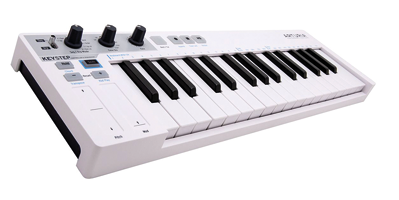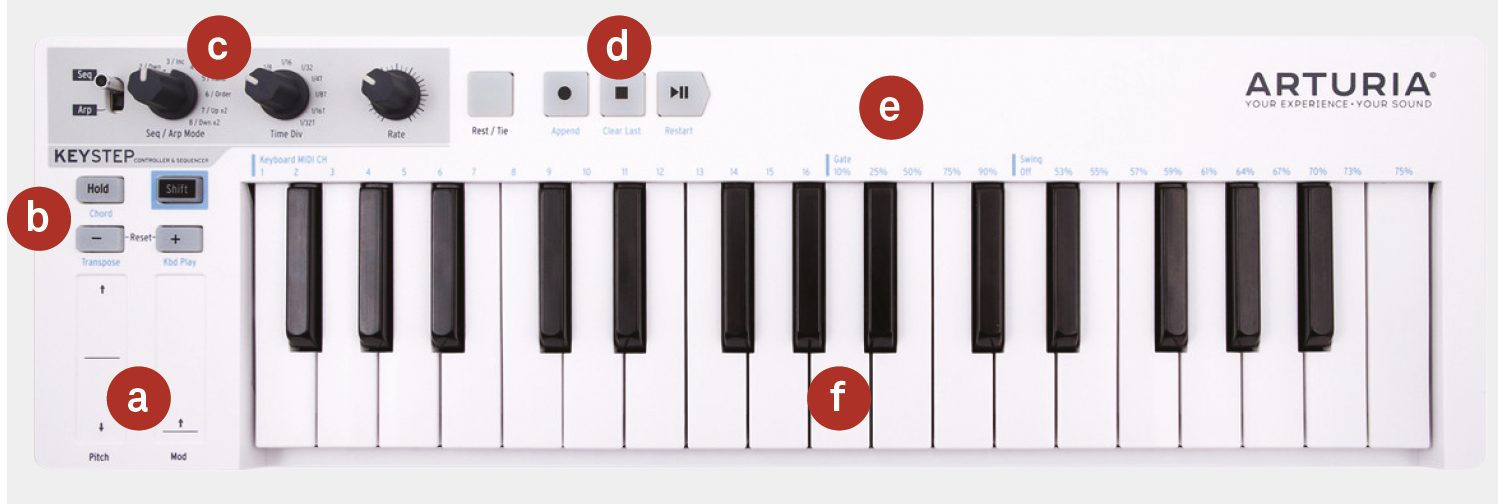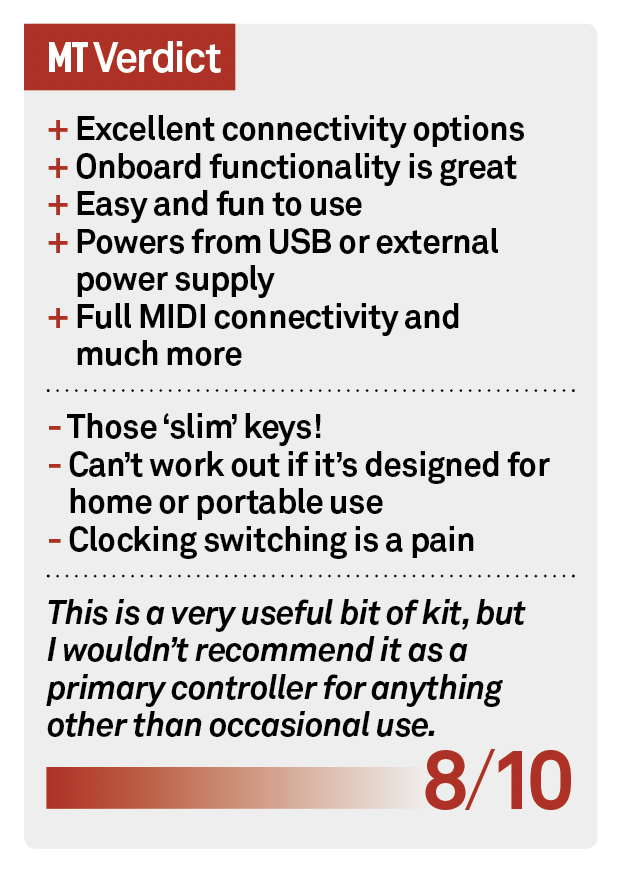Arturia KeyStep Review – The New Lightweight Heavyweight
Controller keyboards that are equipped with CV & Gate are a rare thing, so Dave Gale takes a look at the new Arturia KeyStep, which offers MIDI and much more… Details KitArturia KeyStep Manufacturer Arturia Price £99 Contact Source Distribution – 020 8962 5080 – www.arturia.com Arturia has something of a reputation for coming up […]

Controller keyboards that are equipped with CV & Gate are a rare thing, so Dave Gale takes a look at the new Arturia KeyStep, which offers MIDI and much more…

Details
KitArturia KeyStep
Manufacturer Arturia
Price £99
Contact Source Distribution – 020 8962 5080 – www.arturia.com
![]()
Arturia has something of a reputation for coming up with products that might fulfil a multitude of needs. The BeatStep Pro is a good example of a product which can be interfaced with all manner of equipment, from a computer to a Eurorack and beyond, but given its step sequencer credentials, it’s pretty likely that it will mostly appeal to people with synthesisers or modulars, who want something at the centre of their system which is useable and flexible and –criucially – not a DAW.
Important as this is, the BeatStep Pro is not designed to be played by anyone wishing to be more virtuosic, in the musical and pianistic sense: so now the KeyStep enters the arena, to look after the demographic who missed out.
The Full Range
Starting with the obvious, the KeyStep offers a two-and-a-half-octave keyboard, with octave switches, in an apparent ‘slim design’. I’ve always thought that the lack of the word ‘mini’ in this environment is something of an avoidance tactic, as we all really know what they are, so it’s best to go into a purchasing contract with this full knowledge in mind. But then it is designed to be portable, which in turn raises another question.
If it’s designed to be portable, why is it so long? Partnered with my 15-inch MacBook Pro, it was too long to fit in my laptop backpack, which of course means carrying it around separately, which sort of defies the whole logistical point.
Anyway, placing these points to one side, it has plenty of other features going for it. There are capacitive-touch pitch and mod wheels, which work incredibly well, along with a smattering of glowing, ergonomic buttons, all of which have tasks and secondary tasks assigned. The main features are primary, such as octave switching and transport commands, but there are also three pots for control of tempo rate and sequencer/arpeggiator functions.

I wanted to dive in, so I started by connecting the USB cable to my computer, which immediately brought the KeyStep to life in a flash of lights. Plugging up a pair of cables coming from the CV & Gate outputs, I immediately had keyboard control of my modular with a minimum of fuss, so I turned to the arpeggiator, which required a quick press of the transport ‘play’ button for arpeggiations to spring into life.
There are eight arpeggiator patterns, although it did take me a moment to find Up & Down, as there are two modes available here – inclusive or exclusive – which refer to whether the extreme notes are repeated in sequence.
Thanks to a helpful Hold button, it was possible to arpeggiate and move easily from chord to chord, although I have to mention that here, the mini nature of the keys started to grate.
I found my fingers unsuccessfully pushing down certain notes when lodged between the rather small gaps between black notes.
Switching to Sequencer mode, the Arturia KeyStep offers a full 64-note memory, with the ability to store up to eight sequences. The Tap tempo button also serves as a ‘rest’ input button, when in Step mode, making pitch entry very easy, and for a musician, far easier and quicker than with a more step-like device, such as the BeatStep Pro.

Single-note entry is very much the modus operandi when working with a single-voice modular, but hooked up to a computer or other MIDI device, polyphonic chordal sequencing is available, up to eight notes per step, which is a nice party trick.
Alongside the CV & Gate outputs, there is also a ‘mod’ output, which is largely assignable, allowing a further CV to be controlled and sent modular bound, from velocity and aftertouch.
Making Those Connections
The one area where the Arturia KeyStep is not lacking is in the connectivity side. Allowing power from either computer (USB) or USB-based ’phone charger makes connection easy and convenient: but also allowing for interfacing with CV -based modulars, including generating and responding to a clock as well as MIDI, is definitely impressive.
It will also connect to an iPad via a camera connection kit. There are MIDI sockets built right into the keyboard, so it’s nice not to see a MIDI-socket cable dangling on a device of this kind, and there is a curious Sustain pedal socket; curious, because I can’t see how it is possible to play a keyboard of this size pianistically, which calls into question the need to plonk down sustain, at least in my view.
The KeyStep will ‘clock’ either internally, or to external devices, and seems to do so with great ease, with one small caveat. Clocking options are controlled by a pair of ‘dip’ switches on the rear of the unit, which are very small and fiddly to use. I’m mystified as to the decision to site and use these switches, in the way that Arturia does, particularly as the BeatStep Pro has a nice button with illuminated legends. Would it not have been possible to adopt the same system on the KeyStep?
Arturia KeyStep Overview

a: Touch Wheels – Capacitive-touch wheels, which work incredibly well, given their form factor.
b: Octave & Hold – Octave switching is easy, along with a useful Hold button for those arpeggiating patterns.
c: Sequencing and ARPS – Three pots control sequencing and arpeggiating duties, along with the master tempo control.
d:Transport Controls – Transport controls that are clear and easy to work with, and illuminate when in use.
e: Extra Functions – There are a number of additional functions available, deployed in conjunction with the ‘Shift’ key, corresponding with the blue legend.
f: Slim Keys – Those ‘slim’ keys! They are nice and tidy, but their size could be an issue for some.
Do I Really Need This?
I think that for most people, the idea of a permanent controller keyboard of this size is a bit far fetched. The size of the slim keys is a limitation, and not just to me! If you watch the Arturia demo, you can see one of three guys trying to ‘solo’ on one, and clearly struggling to play in time as he grapples with the mini keys, so I think this will largely appeal to Eurorack people who want a convenient way of getting note triggering to happen with their modular, for a good price.
The addition of the arpeggiator and sequencer is the big sell for me, as they are both great, but the clocking switches are a little bit of a wind up, especially when compared to the BeatStep Pro switching, which is simplicity itself.
Alternatives
If you’re after a nice controller for your Eurorack, I would look at a MIDI keyboard of some kind, and plug it in to a Eurorack interface, such as the Studio Electronics or Pittsburgh Modular MIDI 3. There is no sequencer function, but it will work both monophonically/duophonically, and has an arpeggiator built in.
A number of companies make small, portable MIDI controllers that will hook up to a computer or tablet, but if you want something ‘in’ your Eurorack, as opposed to external, the Verbos Electronics Touchplate keyboard is very nice, as is the new Pittsburgh KB-1 touchplate controller, which also doubles as sequencer and arpeggiator.

The new lightweight heavyweight from Arturia, packing a truckload of functionality and connectivity
Arturia KeyStep – Conclusion
I like the concept of the Arturia KeyStep a lot, and, as is my way, I found myself getting lost in the arpeggiation, sequencing and clocking possibilities – always a great sign that a product has go something very right.
The huge connectivity, coupled with the functional control of the sequencer/arpeggiator, makes KeyStep stand out in the market, but it somehow feels that due to its size, it’s neither portable, nor the correct size for home use.
The Arturia KeyStep feels weighty, but the keys don’t inspire quality-confidence; however, this is a MIDI controller for under £100, so it’s hardly surprising.
The Arturia KeyStep is almost in the area of an impulse buy, and I can feel the urge to place one right next to my Eurorack, when I need a quick arpeggiator fix. So if you can work with the mini keys, and would like flexibility in usage, this is a bit of a bargain.



